How to make Roasted Brown Chicken Stock (and young love in the summer)
The first summer we were married, our situation wasn’t exactly ideal for two starry-eyed newlyweds doing life together. I finished late at night at a popular fine dining establishment where I worked the line and Danny rose early to meander through the Plateau to morning class at McGill. One of us was always tired when we greeted each other at the end of a day, and one of us frequently smelled of soup, but I’m not telling who.
Fed up of only seeing my husband from midnight to 6 AM, I petitioned my boss for day position as a prep cook. I may have stammered, blushing, through my reasoning, but he only twinkled his eyes at me and agreed, that just for the summer, I could work days, and he would find someone to cook the fish and the foie in my place at night.
Stepping down the ladder rung of the competitive kitchen hierarchy was not a move that gained me respect among my co-workers, but I always have (and continue to do so) put family first over ambition. There were stares and a few snickers when the new work schedule came out, but I was elated. A ‘normal’ 9-5 job in fine dining is almost unheard of and these new hours suited me to a T.
Eight blocks north of the kitchen, in our tiny apartment on St. Denis street, I went to sleep and woke up in Danny’s arms. We went out for coffee and fresh croissants in the mornings before parting ways, with lingering kisses, at the corner of Duluth and St. Denis.
Making stock was always the first order of the day, for it required long hours of simmering at an unhurried pace. I cranked the ovens to 400 degrees down the entire line and set to roasting bones for duck stock, veal stock, venison stock, and roasted guinea fowl stock, the essence of which I’m sharing today. I attacked a tray of carrots, onions and celery for my mirepoix, those flavoring vegetables essential for every stock, and gathered fresh parsley, bay leaves and peppercorns. By 10 AM, the massive sturdy pots would be set over burners with bones, mirepoix and cold water, and I would assess my prep list, left for me by the cooks the night before, and organize my day.
I’ve always preferred to work alone – with space to move and work, and peace and quiet to think. However my solace only lasted until 1 PM, when the sous-chef and the chefs du parti arrived and descended on the kitchen, refreshed and excited for a new shift. Closer to 2 PM, the line cooks slipped slowly through the door, squashing their cigarettes on the stoop, reluctant to bid au revoir to the warm summer day. The afternoon light slanted in each time the door opened, as if beckoning me to come out and play. Soon. Soon.
Every day, as the minute hand ticked toward five-o-clock, the pressure mounted in the kitchen. I would wash and dry my knives, and averting my eyes from my panicking line cooks who were struggling to get their mise en place in order. Just as the first tickets came in, I would slip off my clogs, toss my dirty apron, bid everyone a “Bon Service!” and flee out the back door. Freedom.
Danny was always waiting for my escape, his laden-down backpack hanging between his shoulder blades, and his eyes shining brighter than the glinting August sun. Hand in hand, giggling, we would flee the alleyway, and turn onto the cobblestones of Duluth. The whole evening stretched out long before us and it was a delicious feeling. Sometimes we would pick up cheese, salami and a baguette and make a picnic of it in Parc Lafontaine, where one could catch a free concert or a ballet at 8 at the open-air Théâtre de Verdure. We were virtually penniless, but other days the draw of a poutine and a pint of cold house cider at Au Pied du Cochon was too strong to resist.
My favorite dinners, though, were the ones we cooked together, in our warm kitchen -our honeymoon kitchen- with its high ceilings and next-to-no counter space. Always a planner, I would bring home a small container of stock from the restaurant (carefully recorded in the ledger under ‘Staff purchases’, of course) and turn it into a sauce that never failed to elevate our simple bowls of pasta. Eventually, our dreamy season of new love would be over and I’d work late into the evening while Danny pored over textbooks. But much like how bones are simmered long and low to infuse a good stock, we lived the summer to its fullest, recognizing the magic those early days held, and extracting the essence of each moment.
7 Principles of Making Stock
As often as I make stock, which is about every two months in great big batches, I think back to my restaurant days and the methods we used to achieve the best results. A great dish is only as good as its sauce, and the base for most sauces is a perfect stock.
Here are seven guidelines to help you achieve it:
- Start the stock in cold water.
- Simmer the stock gently
- Skim the stock frequently
- Strain the stock carefully
- Cool the stock quickly
- Store the stock properly
- Degrease the stock.
Now that’s about as technical as we’re going to get for this post. I don’t want you to get scared off by a list of rules, when really, making stock is perfectly simple.
Roasted Chicken Stock 101
We’re going to learn how to make a brown, roasted chicken stock today. I use this stock in soups, sauces, gravy and pasta and anything that needs a real boost of flavor. Sure you can make a nearly-clear, light chicken stock with raw carcass or legs, but roasting the bones intensifies the flavor and gives a beautiful rich color.
You can make it with chicken, veal, beef, duck or wild game bones. In this recipe, I use chicken carcasses that I asked my butcher to reserve for me. It looks like a lot of steps, but once you make your first batch, you’ll have learned a new life skill.
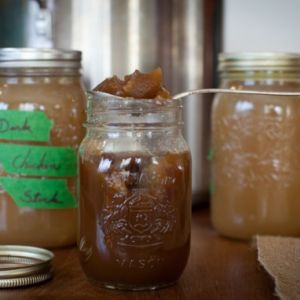
Ingredients
- 10 chicken carcasses
- 3 gallons cold water approximately
- 2 large onions peeled
- 1 large leek washed
- 4 sticks celery washed
- 2 medium carrots peeled
- 2 bay leaves
- 6-8 cloves garlic
- 1/2 teaspoon whole black peppercorn
- 1 handful fresh parsley
- 2 sprigs fresh thyme
- 2 Tablespoons tomato paste optional
Instructions
- Preheat oven to 350° F.
- Do not rinse the bones, but place them directly in a large oiled roasting pan. If desired, brush them quickly with tomato paste (this adds more colour and flavour to the stock).
- Roast the bones, turning once with a sturdy pair of tongs, until the bones caramelize, approximately 1 1/2 hours. Do not let them burn, or your stock will be bitter.
- Meanwhile, prepare your mirepoix: roughly chop the onion, leek, celery and carrots and toss them with a little oil.
- Place them in another oiled roasting pan or sheet, and roast alongside the bones until lightly caramelized, approximately 25 minutes.
- Remove bones from oven and transfer to a large stock pot. There will be a pool of fat at the bottom of the pan which you can drain off before deglazing the pan, or you can add it to your stock. It will only add more flavour to the final product.
- Add a few cups of cold water to the roasting pan to deglaze it, and use a solid spatula to lift off the remaining food particles on the bottom of the pan and all the flavour they bring. Add mixture to the pot with the bones.
- Add roasted mirepoix, herbs, garlic, peppercorns and bay leaves to the pot of bones. Fill pot up with cold water until the ingredients are just barely submerged and place on stove burner.
- Bring stock to a boil -- and reduce heat immediately. Simmer slowly for 6-8 hours, occasionally skimming excess oil or scum off the top. You don't need to babysit it much, just make sure it is at a temperature where it will will simmer, but not boil.
- Using a sturdy spider skimmer, dip into the large pot and fish out the bones. Allow them to drain a bit and then toss them in the garbage. (I usually haul my garbage bin right over to the stove, to make things easier.) When you have fished out all the large ingredients, strain the broth through a fine sieve into a sturdy bucket or another pot.
- If you have the time and patience, strain the stock a second time through a cheesecloth to further remove impurities.
- When it is at room temperature, divide among sanitized covered containers for storage. Mason jars work well for freezing, but be sure to leave at least 1 inch of head space to allow for expansion.
- Don't worry if a thin layer of fat forms at the top of your containers. This helps preserve the stock and can easily be removed with a spoon before using.
- Stock can be stored for up to one week in the refrigerator or frozen for 3-4 months.
Nutrition
Note: excerpts from this post have been republished from a September 2010 post on making stock.
We’re kicking of a new year of our Eat Well, Spend Less series by getting back to basics in the kitchen. Simmering a homemade stock is an excellent start to eating better and cutting down on grocery costs.
Tip: Try making your own vegetable stock sometime. It serves two main purposes: it uses kitchen scraps that might otherwise go into the garbage (or hopefully the compost) and it yields a fragrant broth that is suitable for a myriad of dishes.
Look for a full round-up of Eat Well, Spend Less back to basics from participating bloggers later this week.
How will you use your roasted chicken stock?

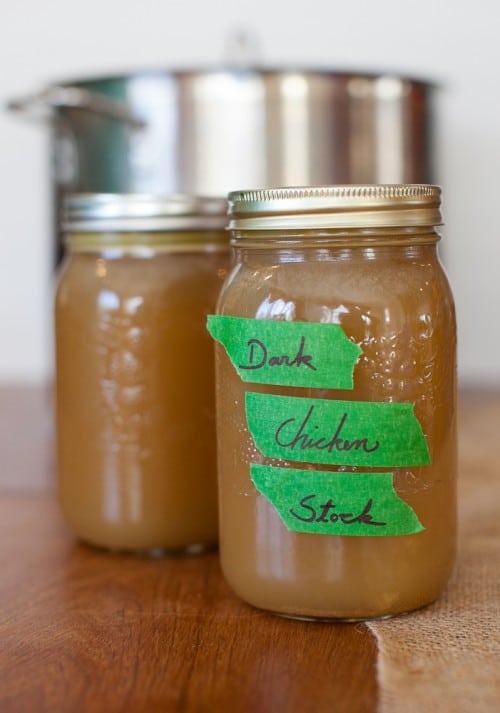
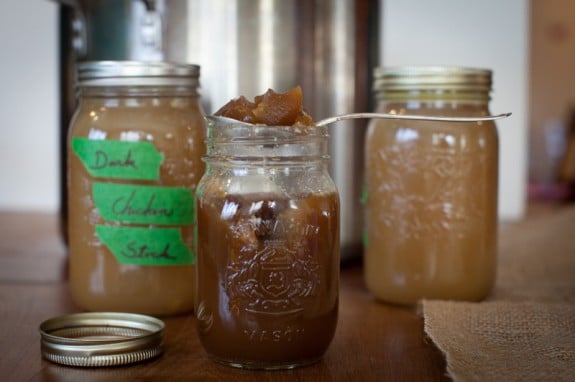
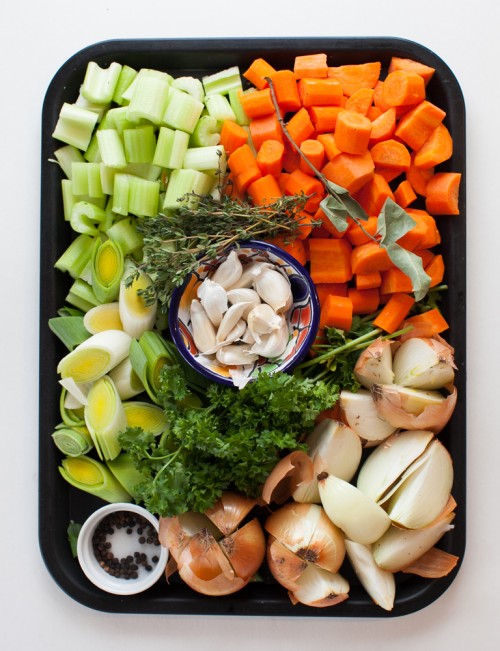

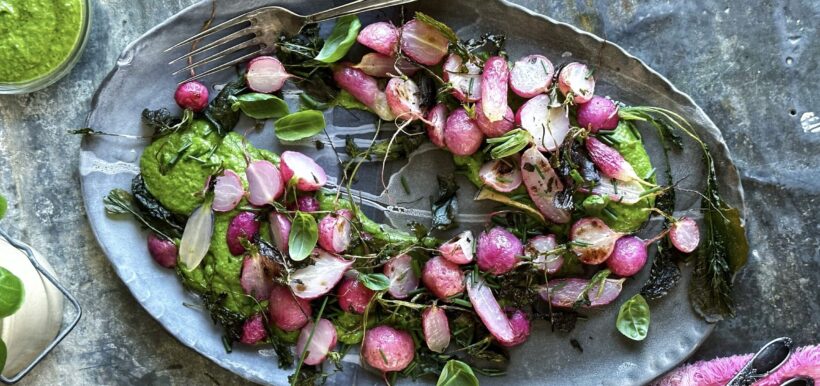
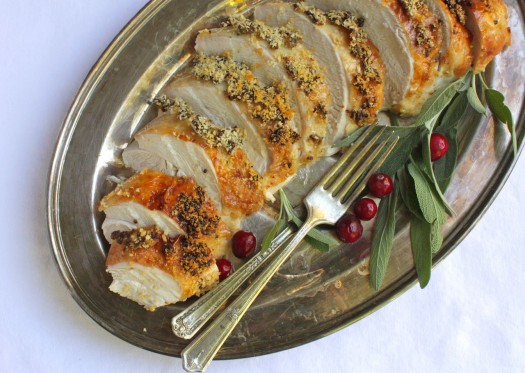
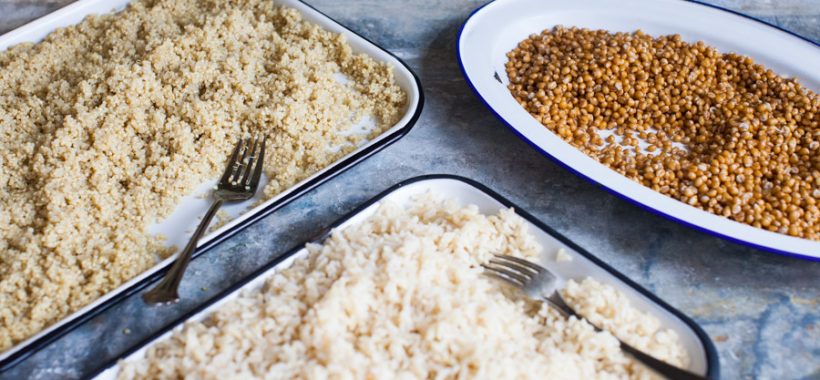

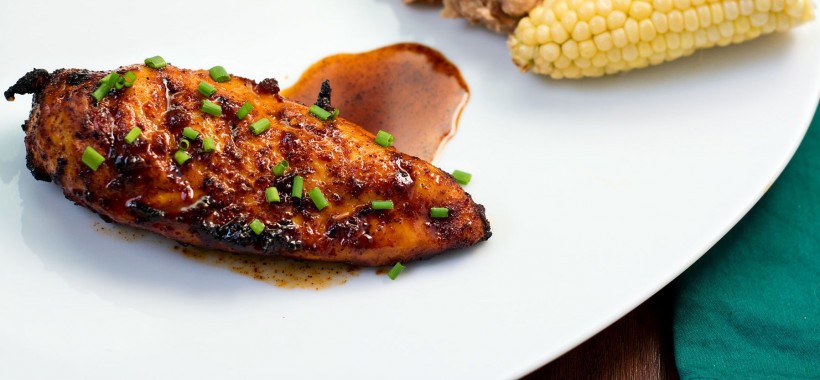
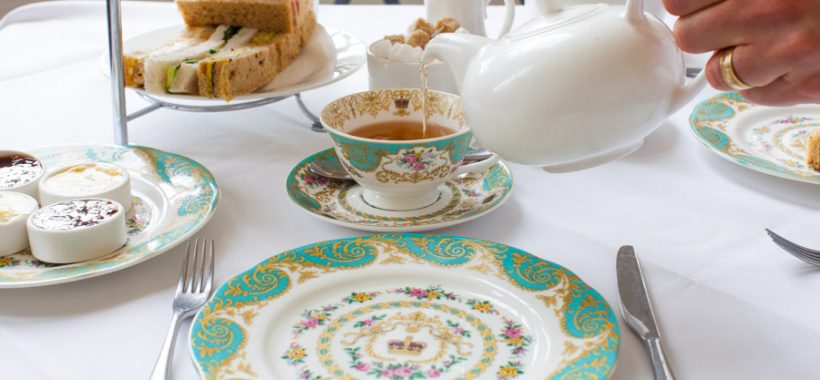
Hi Aimee! I’m constantly always trying to make my own stock (and usually I succeed), but I like your idea of browning the ingredients first, definitively will try that for my next batch. I also have a question: do you thing that after the boiling step would it work to transfer everything to a crock-pot and do the simmering there?
That would work really well, Marcia. I would crack the lid ever so slightly as stock reduces.
Thanks for answering! I will try it next time!
I loved this post, Aimee! The most beautiful and romantic chicken stock post I’ve ever read. 🙂
Aw, thank you Robin. I don’t know what happened last night, but when I sat down I felt like I had a story to tell. =) The cold weather outside makes for an ideal time to curl up inside and write. Thanks for reading and commenting!
What a sweet story!
I love making my own stock, next time I’ll have to roast the chicken bones. Thanks for the great recipe!
I love to make soups but never thought of roasting the bones & veggies first, thank you so much for writing this post and helping me take my cooking to a whole new level.
Thank you for stopping by! You’re going to love the boost of flavor roasting the bones + vegetables brings to your soups and sauces.
I loved reading this story perhaps as much as you enjoyed remembering and writing it.
I’d read in my old 1950 Betty Crocker New Picture Cookbook to pour the strained hot stock into canning jars that would keep longer in the fridge due to the fat layer on top. Nice to see that bit of wisdom echoed here as well.
Thanks!
Thanks for reading, Kristen. It was a long one. =)
I have read that you should add a few Tbsp of vinegar when you simmer the bones, this helps pull more of the nutrients out of the bones. Easy way to make your broth even healthier 🙂 Great post, love the story!!
That’s a good tip, Christine, and that is true, it can help extract the calcium from the bones. I think you have to simmer it REALLY long, though, to have any effect, and it won’t smell as nice. =)
I am definitely going to have to try roasting first the next time I make chicken stock!
Beautifully written, sweet friend. It’s always intriguing to hear a good back-story. 🙂
Thank you, Sommer. It was a fun trip down memory lane. Memories that I am feeling more and more compelled to write as they are fading the older I get…Thanks goodness for blogs. =)
This sounds so good, and I love your story! Can you recommend some recipes to go with the stock? Thanks for sharing!
Good question! For me, the dark stock really enhances dishes where chicken is the main flavor like this Chicken with 40 Garlic Cloves: https://simplebites.net/my-secret-for-easy-entertaining-during-the-cold-weather-months/
or One-Pot Lemon Chicken:
https://simplebites.net/one-pot-lemon-chicken-and-zucchini-with-rice/
Hope that helps. =)
Aimee, you had me at “mirepoix”, “family first”, “eyes shining brighter than the glinting August sun” about your hubby and “new life skill” in this heartwarming and informative post. (You deserve a food writing award for this post alone. I would vote for it to win!) Blessings will always come your way when you put family first. You are a doll. And, yes…roasting first puts stock in a whole new class. I even pan-fry the turkey neck & giblets before making my Golden Tangerine Turkey Giblet Stock. (Learned this excellent tip from Chef Wolfgang Puck’s recipe.) But, now, I know that I should roast the veggies as well for an exceptional stock. Thank you for romanticizing stock making and for putting all those fab stock making tips together in one cohesive list. BRAVO! xoxo
Thank you for your kind comment, Stacy. It means a lot to me that you read every word. =)
That is a wicked-good tip about the turkey neck. My turkey gravy is always rather, well, um, gray…
Thanks for sharing this post on Twitter and Pinterest! Have a great weekend.
What a great tutorial! This is very helpful!
omg you two are the cutest – that was a really sweet love story 🙂
and roasted stock is my fav! way more flavor and makes for the BEST soups and sauces! xo
I knew you’d agree. It makes the house smell like roast chicken too, and that is always a good thing.
I make my own stock as well, but rather than adding whole carrots, celery, and onions, I save the scraps/peelings from them in a bag in the freezer. Then I just add those to my stock so they’re not wasted and I don’t have to use fresh ones.
I like to use my chicken broth to make soup, gravy, or as the liquid to make rice. It makes for a nice savory rice. Just don’t use the leftover for rice pudding. But they do make for great fried rice.
I also save the chilled fat from the top and substitute it for about half the butter when making mashed potatoes (and add a little of the broth too). It makes them super tasty, saves on the cost of butter, and makes use of something that would otherwise be thrown away. I also save the fat from beef broth and use that to sear beef roast and the meat and veggies for beef stew. And if I don’t use all the fat for cooking, my cats sure appreciate it melted over their kibble (as an occasional treat).
Me too, except for the cat kibble – I’ll see if she likes it.
Great suggestions, Jenny. I’ll save the fat sometimes if it’s a good organic chicken. I like to fry potatoes in it. =) Thanks for commenting!
I have had such a hard time making a good stock. It is usually pretty bland… Will definitely try your tips.
I usually make my stock from leftover roasted chicken carcasses that I make for my family. I just toss them in a freezer bag until I have 3 and then make the stock from that. Do you think it would be wise to roast just the bones again before I make the stock? Or would the bones burn since they had already been roasted once, albeit with meat on them?
Also, seriously, one of the most romantic things I have ever read on the web. Wow!
I do the same thing and had the same question 🙂
I am really hoping Amiee will be able to enlighten us on this one 🙂 I hate to let those leftover carcasses to waste!
Thanks for the great article, Amiee! What a delight to read 🙂
I don’t think there’s any point in roasting the cooked chicken carcasses. You’re still going to get a darker stock.I find that stock made from a rotisserie chicken isn’t very potent (and maybe a bit greasy), but I say it’s better than no stock!!
PS. Thanks, both Alyssa and Loretta, for the kind words. This post was long and I just appreciate you taking the time to read!
Thanks for the response, Amiee!!
I usually roast my own chicken and then pick it clean and use it. The stock sometimes ends up salty. Is there anything I can do about it?
Thanks!!
-Alyssa
I loved this post! Such aa beautiful story. We always opt for a simpler stock, and I’ve never roasted the bones before. Looks like it’s time to up my game.
Aimee, this was the best post I’ve read all week. So romantic, thoughtful, and it really showed your beautiful character. I’m happy and eager to make some more stock 😉
Hi Aimée, I loved reading your story on this icy morning. It reminded me of some lovely memories of my own. I used to live in Montréal when I went to university and have many fond memories. And I also spent a magical first summer with my husband, when we were both working at the same fine dining restaurant and would go spend mornings at the beach before heading to work in the afternoon and then finishing of the evening with a bottle of wine in our front porch. Ahh, good times!
Now I have no excuse NOT to make my own chicken stock!
I loved your story. Thank you so much for sharing. I’m looking at the picture you have in the post of the finished product and it looks a bit gelatinous. Is that true? I’m cleaning out my freezer and so I pulled out the Turkey carcass that I had stored in there from Thanksgiving and finally got around to making some “broth” with it. Well, it was on the stove for quite a long time (several hours as I forgot about it). I portioned it out and froze most of it but I left some in the fridge to use the next night. But when I pulled it out of the fridge, it wasn’t liquid. I was so surprised. I am figuring that since gelatin is made from bones, maybe this is what happens when you cook it for this long. I was just using it to cook brown rice so I put in less than normal and then supplemented with water so that there was enough liquid to get things going. The rice was good so it worked out … I’m just wondering what is going on.
Yes, cooked bones will release gelatin – that’s how you know it’s a really yummy homemade broth! When the broth is cooled, the gelatin sets, but it should liquefy as soon as you heat it again. Gelatin is really good for you, so pat yourself on the back for making something so good and for using it even when you were unsure!
what a beautiful love story! i could picture all of it through your great descriptions. i felt like i was reading it out of your diary or something 🙂 this is a great how-to on making stock on our own!!
I loved reading this. We spent four months in Montreal while my husband studied music through a teacher at McGill. All those places and the sights and the sounds and the young lovers brought back so many memories of my own.
And I have never made stock like this. I will be trying it soon. Thanks for the lovely words.
Ah, so you know the charm of Montreal in the summer. Thanks for commenting.
What a sweet, romantic story! You told it perfectly – I can just see you slipping away, hand-in-hand and googly-eyed, after a full day of work/school. But, besides that…
I never thought to roast the vegetable, too! I can’t wait to try it.
What a sweet story, thanks for sharing. But I want to know how you arrive with 10 chicken carcasses?
Good question, Rhonda. I had to stalk my butcher for them. I called in advance an asked them to save about 10 carcasses for me, necks intact (the necks make the best broth). They called a few days later and I picked them up for $5.
You guys are the cutest. And even if I were penniless, I’d find a way to get poutine et cidre from APDC too. Some things (like love and family) you have to prioritze!
this story is magical! What a way to introduce stock! 😉
LOVE! What a treat to read this afternoon.
I started making my own stock and always get a kick out of how much “free” stuff comes out of something I would have otherwise thrown in the compost.
What a lovely post and sweet lover story! I do have a question about the stock recipe (which looks amazing) since I will attempt it this weekend: you mention leeks in the instructions (step 4) but not in the ingredients. Is leek a potential substitute for the onion or should we add some leeks as well for more flavor?
Oops. Sorry about that. yes, I added one leek. It won’t change the flavor much, but it was wilting in my fridge and so I threw it in. Thanks for catching that. And thanks for reading!
I love everything about this Aimee! The story and the beautiful comforting recipe! xoxox
What a sweet story for this perfect staple.
Love your post today Aimee. I used to be die hard on making my own stock and I should take the time to do it! It is rewarding.
On a separate note, as a newlywed my husband demanded me to take my clothes off first thing as I walked into the house……because I smelled of yeast, sweat and eggs. True, I stunk! Many folks think when you work at a bakery you smell like sugar and spice and apparently that is not true. Not the glamorous life. 🙂
Steamy!
I’ll still hold romantic notions in my head about bakery life…
Aimee, this is such a lovely post. I love when you share stories like this!
I made a venison stock with your older stock recipe this past fall. It turned out so great! This week I made a turkey stock that we turned into turkey barley soup…. it turned out wonderful, but I managed to spill it all over my hand while straining it. :-/ Second degree burns from turkey stock are not too much fun!
I love your story! Thanks for sharing and this beautiful recipe.
Thanks for the wonderful post. Love the back story. My first year of marriage involved removing clothes when I got home too….I was in veterinary school. Smelling like chicken stock or a bakery would have been better. 🙂 I use my homemade chicken stock in everything! Always adds depth that can’t be copied by anything at the grocery store. Unfortunately, it never comes out the same way twice. I use a mixture of cooked and raw carcasses. I think I’ll roast the raw parts and veggies from now on and see how yummy that can be. 🙂 Thanks!
Aimee, you managed to turn something as hum-drum as making chicken stock into a true pleasure to read. What a wonderful story! And thank you for explaining the steps involved in roasting the bones — I’ve never known exactly how to do it.
Just beautiful, A. Your words were crafted with as much skill as your stock. Can’t wait to try your method and I’ll be thinking romantic thoughts whenever I make stock now. <3
Is there a Duluth in Canada…. or were you in MN??? Reading this was like reading a romantic novel… it has everything I want. Good food, a great love, and a recipe so I can try! 🙂
It’s a street, in Montreal. =) Thanks for reading!
What a beautiful and delicious post, Aimee. I savoured every morsel. 😉
I was hanging off your every word reading this story, thinking back to mine and my husband’s own honeymoon days. And I am definitely going to try my hand at making your stock, having never made my own before – I feel like I can conquer it with your professional advice. 🙂 Lovely post!
How many leeks? you forgot them in the recipe?
Love your story, the snapshot we saw! That was completely and utterly my first married too. Passing each other and only seeing the other for moments a day. (I worked 9am-6pm and my new hubby worked 8pm – 6am)
I read this on my phone the day it was posted, and it put a smile on my face all day long, to think of young Danny and young Aimee, and the adventures you must have had. The gorgeous chicken stock recipe is just a bonus. 🙂
Sounds fabulous! And what a sweet story! 🙂 You mentioned using other types of bones, like beef bones–would you roast those bones for just as long? And do they need to have scraps on them? I have some beef short ribs and saved the bones, but there are no meat scraps. Any idea as to whether they’d still make good beef broth? Thanks 🙂
Oh how delicious!
I’ve been making my own stocks for a while (both meat & vegetable), but I’ve been meaning to incorporate bones because I’ve heard how healthy it is. Your recipe gives me a great place to start–thanks!
Did your butcher think you were crazy for asking for carcasses? I’m going to muster the courage to ask for some!